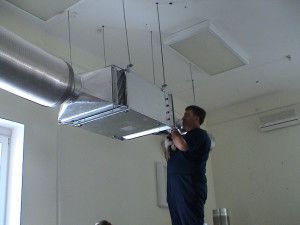
Perfectly calculated, but illiterately mounted ventilation at home will bring a lot of trouble. Lack of consumables when installing ventilation can disrupt the delivery of a large object. Ignorance of the basic technological requirements for the installation of ventilation will nullify the efforts of the home craftsman to create comfort in the house. These errors can be avoided.
- Ventilation installation stages
- Preparatory stage of ventilation installation
- Installation of air ducts
- Ceiling mount
- Interconnection
- Installation of diffusers and ventilation grilles
- Connecting the system to fans
- Testing and commissioning
- Installation rules
- Features of installation of ventilation at an operating facility
- Installation of ventilation in the apartment
- Stages of installation of supply ventilation
- Installing a supply valve with your own hands
- Do-it-yourself exhaust ventilation installation
- Private house ventilation
- Roof ventilation
- Installation of ventilation on a soft roof
Ventilation installation stages
- Preparatory stage: drawing up and agreeing a work schedule.
- Supply of equipment and components for the installation of a ventilation system.
- Installation and assembly in stages: installation of ventilation pipes, interconnection, installation of switchgear, installation of equipment: fans, air heaters, humidifiers, filters, etc., connection of air ducts to equipment, power connection.
- Testing and adjustment.
- Commissioning.
If the old one was dismantled before installing the new system, the “Dismantling” stage is added to the list.
Now in more detail on each item on the list.
Preparatory stage of ventilation installation

Installation of ventilation equipment is carried out on the basis of the work schedule, after its approval and signing by the customer. The terms of reference always takes into account the routing of the ventilation pipes. The work schedule specifies the timing, sequence of delivery and installation of equipment and components for the ventilation system.
In addition to the main elements, you will need consumables for installation:
- corner of various sizes;
- flange tires;
- bolts, nuts, washers;
- self-tapping screws;
- hairpins;
- anchor;
- mounting brackets;
- mineral wool;
- reinforced tape;
- copper pipes and hoses for drainage;
- fasteners with vibration isolation of various shapes.
At the end of some stages of the exhaust ventilation installation, intermediate tests are carried out, the results of which are entered into acts. The installation of the system is completed with commissioning and the signing of the corresponding act. The customer receives a package of documents, including certificates for equipment, diagrams, acts of hidden works.
Installation of air ducts
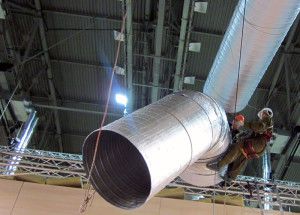
Work can be started if the following requirements are met:
- walls, ceilings between floors and internal partitions were installed;
- ready platforms and foundations for placing outdoor ventilation equipment;
- waterproofing was made in the places where wet filters and supply chambers were located;
- floors and special bases for placing ventilation mechanisms are ready;
- supports for mines, roof fans are ready;
- drilled holes for air ducts in partitions, ceilings and walls;
- the design marks of the clean floor are applied to the walls;
- the walls along the ducts are plastered;
- glazing of external openings was carried out, doors were installed.
First, the project is linked to a real object. If during the linking it becomes necessary to change the project, they are documented.
Stages of installation of ventilation systems air ducts:
- designation of fasteners;
- installation of fasteners;
- delivery of air ducts and consumables for the installation of ventilation;
- assembly of air ducts into blocks;
- lifting blocks to the place of placement and their attachment.
Most often, ventilation pipes are mounted to the ceiling. In residential and public facilities, air ducts are hidden behind suspended ceilings, in which holes are made and switchgears are inserted. In manufacturing, air ducts are usually left open. This makes it easier to access for future repair and service.
The upper ends of the air ducts, located above 1m 50cm from the floor, must be closed with plugs.
Instead of rigid corners, adapters and turns, you can use flexible corrugated pipes made of aluminum foil, fiberglass. During installation, they are stretched as much as possible. Corrugated pipes are not installed on straight sections.
Ceiling mount
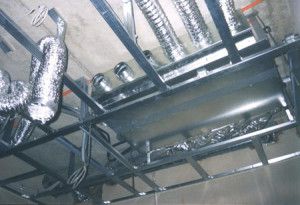
Before starting the installation of the ventilation system, it is necessary to inspect the areas and determine the best methods of fastening. The equipment is attached to the ceiling using fasteners:
- studs;
- mounting punched tape;
- anchors;
- clamps.
Fasteners are selected depending on the severity of the pipeline and the length of the lines
Interconnection
When installing ventilation pipes, two connection methods are used:
- flanged;
- nipple.
The flange is sealed with a special tape. And the finished joints are additionally sealed with aluminum tape or silicone.
Installation of diffusers and ventilation grilles
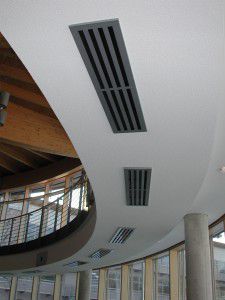
Switchgears are attached to the duct in two ways:
- Direct or self-connecting - the grille is attached directly to the duct;
- Using an adapter.
When installing ventilation in private houses, apartments and offices, grilles are chosen as distribution devices, in production - diffusers.
Connecting the system to fans
The main task at this stage is to create sealed and strong connections. Otherwise, during operation, the equipment will emit an excessive rumble and air distribution in the pipes will be disrupted.
An important stage in the installation of supply and exhaust ventilation is the connection of automated control systems. ACS ensures the maintenance of air indicators within the required limits, monitors all units and signals malfunctions.
Testing and commissioning
At the end of the assembly of the system, it is tested, the equipment is adjusted to the design values and put into operation. Both the operation of the system as a whole and its individual units (valves, dampers, etc.) are tested. For equipment that has passed all the tests, a passport is issued.
Installation rules
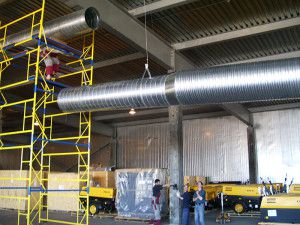
Requirements for the installation of ventilation systems are set out in SNiP 3.05.01-85:
- The installation of the system is carried out in accordance with the approved project;
- When installing the air ducts, the longitudinal seams are placed up;
- All pipe bolts are tightened as tightly as possible;
- Air ducts are attached to mechanisms only after installation;
- When placing the air duct, take into account: its mass should not be transferred to mechanisms;
- When attaching fans and air ducts, vibration-insulating materials are used;
- Radial fans are mounted on rigid supports and fastened with anchor bolts;
- The electric motors are attached to the fans after careful fitting;
- The filtering surface should be uniform, without sagging or folds;
- The fan impeller must rotate freely;
- The entrances to the system are covered with ventilation grilles with a mesh size of no more than 7x7 cm;
- When installing the ventilation system, it is advisable to minimize the number of turns, transitions and bends that create resistance.
The rules for installing ventilation systems are mandatory and guarantee the stable operation of the equipment in the future.
Features of installation of ventilation at an operating facility
When working with existing buildings, it is important at the initial stage to determine the dimensions of the ventilation units in order to immediately assess the scale of the work.
If the building has already been put into operation, the installation of the ventilation system is somewhat complicated. In some cases, it is not technically possible to lay ventilation shafts of the required diameter. We have to change the project and select the appropriate option.
Installation of ventilation in the apartment

The installation of ventilation in the apartment is somewhat easier. First, owners need to decide on the type of system they would like to see in their home:
- supply;
- exhaust;
- supply and exhaust.
Further, on the basis of the apartment plan, a ventilation project is drawn up and equipment is selected.
Stages of installation of supply ventilation
The installation diagram of supply ventilation in an apartment may vary slightly depending on the configuration. With certain skills, you can do the installation of the ventilation system with your own hands.
Stages of installation of standard supply-type apartment ventilation:
- choose the installation location;
- designate future holes;
- We cut holes for an air duct with a diameter of at least 12.5 cm. The hole is drilled at a slight angle to the street, for the condensate drain;
- measure the duct of the required length (wall thickness + fasteners) and cut it off;
- we install the air duct, we attach the valve from the outside. The valve axis must be aligned with the vertical;
- foaming up the cracks between the wall and the duct;
- we fasten the ventilation unit casing to the wall using the recommended fasteners;
- we insert filters into the supply air duct;
- now we insert the heater and connect it to a special socket;
- we attach a protective grill outside;
- we supply and connect the electrical wiring.
Installing a supply valve with your own hands
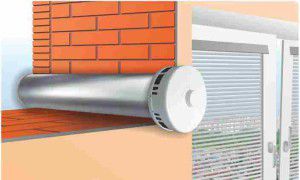
The simplest model of supply ventilation is a valve that is easy to install with your own hands.
Such an inflow consists of the following components:
- plastic air duct;
- external air distributor;
- filter;
- soundproofing;
- thermal insulation;
- control valve;
- internal air distributor.
Since the efficiency of the supply valve depends on the health of the general ventilation of the house, you should make sure that it is working.
Installation of the supply ventilation valve is carried out as follows:
- choose the installation location. The best is between the radiator and the window sill.
- we drill a hole for an air duct with a slight slope towards the street, usually with a diameter of about 5 cm, insert a pipe;
- a distributor and an intake device are attached outside;
- the valve body is installed from the inside.
The inlet valve must be cleaned, the grates and filters must be rinsed once every 6 months.
Do-it-yourself exhaust ventilation installation
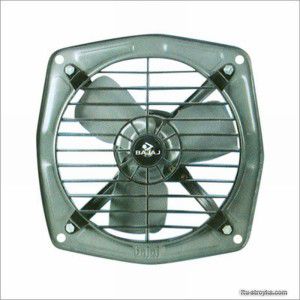
- In the kitchen, the hood should cover the space above the hob. In this case, it is impossible to completely cover the exhaust grille located in the upper part of the wall;
- In the bathroom, it is advisable to power the exhaust device from the light switch. This will save energy;
- In apartments, the ventilation of the bathroom is a single box that goes into a common shaft. To prevent air from the bathroom from being drawn into the toilet and vice versa, the fans are equipped with non-return valves. This simplest device is a lightweight plate on a horizontal axis. It allows air to freely leave the room, but does not let it back in;
- When choosing a bathroom fan, you should pay attention to the degree of protection against moisture;
- Silent models of modern exhaust fans use more electricity than standard ones;
- Fans in polyisopropylene (ABC) or acrylic casing are more reliable and durable.
Private house ventilation
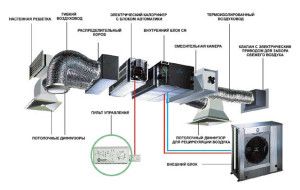
In modern cottages, preference is given to the installation of supply and exhaust ventilation systems. This turnkey solution fully provides a comfortable indoor environment.
Roof ventilation
Installation of roof ventilation consists in the installation of roof and ridge valves and aerators. These devices are specially designed for roof and attic ventilation. They can be continuous and point.
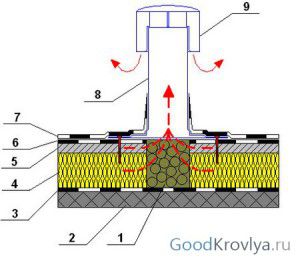
On average, one point aerator serves 20 sq. m. roof.
Aerator design:
- branch pipe;
- roof mounts;
- cap and nets, covering the pipe from rain, dry leaves, birds.
For exhaust ventilation of the attic, a special adapter is attached to the valve, to which a branch pipe is mounted to the attic.
- The number of aerators depends on the shape and area of the roof; there should be gaps of 10 - 12 m between the devices;
- With a pronounced ridge and valley, roofing valves are installed on the watershed in the valley, as well as along the entire ridge;
- For buildings with high humidity, specialists should calculate the number and placement of valves;
- When installing ventilation in a private house or apartment, it is necessary to check the position of the air ducts using a building level fixed to the rail.
Installation of ventilation on a soft roof
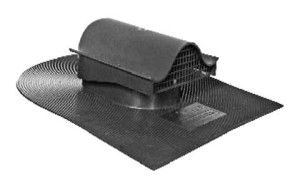
- In the intended place, we make a hole through the insulation, the screed, without affecting the vapor barrier layer. Hole size 8 - 12 cm;
- fill the hole with expanded clay;
- we process the sole of the aerator with a sealant, install it in a prepared place, fix it with self-tapping screws;
- we attach the cover layer of the roofing material so that the valve is located at the junction of the panels, with an overlap of 15 cm;
- at the place where the valve is installed, the roofing material is laid loosely, after which a patch is made, completely covering the base of the valve, with a 15 cm approach to the roof on each side.
Installation of ventilation attic and roof of the house is completed. Whichever type of ventilation is chosen, it is important to have a professional approach to the installation of equipment. And purchase components from trusted suppliers.
Video instructions for installing a walk-through roofing element:








